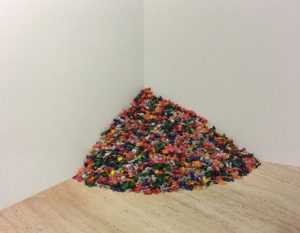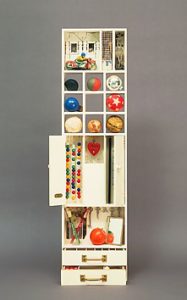by Rachel Mesch
A current exhibit at the Met Breuer museum in New York City features a pile of candies wrapped in brightly colored cellophane. Viewers are invited to take one, so that the work of art– by Felix Gonzalez-Torres–constantly shifts over time. This piece (“Untitled”) is part of the “Unfinished” exhibit—a meditation on artistic practices that probes in one hundred and ninety-three riveting and unexpected ways the question of artistic completion: when a work of art is finished, and what it means when it is not.

Felix Gonzalez-Torres, “Untitled,” 1991
Where does material culture fit into this set of questions? The bric-a-brac-o-maniacs among us are drawn, perhaps, to the material aspect of historical study precisely because of its unfinished nature: the possibility of a continued relationship with the past through direct contact with the objects that it left behind. We collect in order to keep the past from slipping away permanently, to keep it from being over. We deny that the past is finished by continuing to interact with it.
When it comes to the contemporary artworks in the Met’s exhibit, there is a tension within the show itself between the artistic desire to create a work of art built out of a relationship with the viewer and the art historian’s wish to preserve that desire in time. While Gonzalez-Torres’s candies are replenished once a day, a work by George Brecht featuring a cabinet with objects intended to be handled is displayed behind a glass cabinet meant to protect the work from those invited hands. In order to preserve Brecht’s work for posterity, the curators deny its current viewers the full experience of it.

George Brecht, Repository, 1961
I have been chided in the past by museum types for the way that I keep my own collection: the of early twentieth-century French women’s magazines that have been instrumental to my research, and which are now loosely stored in plastic bins. Each time I handle them the edges fray a bit more. Turn-of-the-century bindings slacken. There is an occasional tear. But I did not track these publications down from Parisian book sellers (and internet auction sites) in order to store them behind glass or bury them away in sealed plastic envelopes. The point is to handle them, not just the better to analyze them for my research, but-yes!- to allow the oil from my own fingers to sometimes mark them, if only just a tiny bit. Participating in the magazines’ inevitable entropy—another major artistic trope of the modern works in the Unfinished exhibit—is perhaps a way of working against the ephemeral, fleeting nature of the past. From a professional collecting perspective, my casual contact with the objects that I collect diminishes their value. From the perspective of a bric-a-brac-o-maniac, it is this very contact that keeps the magazine alive, and along with it, the enduring thrill of the unfinished.
**
For further reading, see the wonderful catalog from the exhibit, edited by Kelly Baum and Andrea Bayer, Unfinished: Thoughts Left Visible. Yale University Press, 2016.
